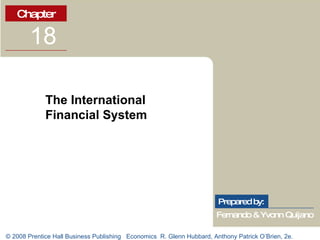
Chap18pp
- 2. Molson Coors Deals with Fluctuating Exchange Rates Learning Objectives The “exchange rate exposure” results from Molson Coors earning revenue and incurring costs in several currencies, particularly the U.S. dollar, the Canadian dollar, and the British pound. APPENDIX Explain the gold standard and the Bretton Woods system . Discuss the growth of international capital markets . 18.3 Discuss the three key features of the current exchange rate system . 18.2 Understand how different exchange rate systems operate. 18.1
- 3. Exchange Rate Systems Floating currency The outcome of a country allowing its currency’s exchange rate to be determined by demand and supply. Exchange rate system An agreement among countries on how exchange rates should be determined. Learning Objective 18.1
- 4. Exchange Rate Systems Managed float exchange rate system The current exchange rate system, under which the value of most currencies is determined by demand and supply, with occasional government intervention. Fixed exchange rate system A system under which countries agree to keep the exchange rates among their currencies fixed. Learning Objective 18.1 Don’t Let This Happen to YOU! Remember That Modern Currencies Are Fiat Money
- 6. The Current Exchange Rate System Learning Objective 18.2 The Floating Dollar FIGURE 18-1 U.S. Dollar–Canadian Dollar and U.S. Dollar–Yen Exchange Rates, 1973–2006
- 8. The Current Exchange Rate System Learning Objective 18.2 The Theory of Purchasing Power Parity What Determines Exchange Rates in the Long Run? Purchasing power parity The theory that in the long run, exchange rates move to equalize the purchasing powers of different currencies.
- 9. The Current Exchange Rate System Learning Objective 18.2 The Theory of Purchasing Power Parity What Determines Exchange Rates in the Long Run? Three real-world complications keep purchasing power parity from being a complete explanation of exchange rates, even in the long run: • Not all products can be traded internationally. • Products and consumer preferences are different across countries. • Countries impose barriers to trade.
- 10. The Current Exchange Rate System Learning Objective 18.2 The Theory of Purchasing Power Parity What Determines Exchange Rates in the Long Run? Tariff A tax imposed by a government on imports. Quota A government-imposed limit on the quantity of a good that can be imported.
- 13. Calculating Purchasing Power Parity Exchange Rates Using Big Macs Learning Objective 18.2A Solved Problem 18-2A 21.6 korunas per dollar 16.2 korunas per dollar 52.1 korunas Czech Republic 942 won per dollar 901 won per dollar 2,900 won South Korea 3.01 zlotys per dollar 2.14 zlotys per dollar 6.90 zlotys Poland 2.13 reals per dollar 1.99 reals per dollar 6.40 reals Brazil ACTUAL EXCHANGE RATE IMPLIED EXCHANGE RATE BIG MAC PRICE COUNTRY
- 14. The Current Exchange Rate System Learning Objective 18.2 The Four Determinants of Exchange Rates in the Long Run What Determines Exchange Rates in the Long Run? • Relative price levels. • Relative rates of productivity growth. • Preferences for domestic and foreign goods. • Tariffs and quotas. There are four main determinants of exchange rates in the long run:
- 15. The Current Exchange Rate System Learning Objective 18.2 The Euro FIGURE 18-2 Countries Adopting the Euro
- 17. The Current Exchange Rate System Learning Objective 18.2 Pegging against the Dollar A final key aspect of the current exchange rate system is that some developing countries have attempted to keep their exchange rates fixed against the dollar or another major currency. Pegging The decision by a country to keep the exchange rate fixed between its currency and another currency. The East Asian Exchange Rate Crisis of the Late 1990s
- 18. The Current Exchange Rate System Learning Objective 18.2 Pegging against the Dollar The East Asian Exchange Rate Crisis of the Late 1990s FIGURE 18-3 By 1997, the Thai Baht Was Overvalued against the Dollar
- 19. The Current Exchange Rate System Learning Objective 18.2 Pegging against the Dollar The East Asian Exchange Rate Crisis of the Late 1990s FIGURE 18-4 Destabilizing Speculation against the Thai Baht
- 20. The Current Exchange Rate System Learning Objective 18.2 Pegging against the Dollar The Decline in Pegging Following the disastrous events experienced by the East Asian countries, the number of countries with pegged exchange rates declined sharply. The Chinese Experience with Pegging In 1978, China began to move away from central planning and toward a market system.
- 22. Coping with Fluctuations in the Value of the U.S. Dollar Learning Objective 18.2 Solved Problem 18-2B
- 23. International Capital Markets Learning Objective 18.3 FIGURE 18-5 Growth of Foreign Portfolio Investment in the United States
- 24. International Capital Markets Learning Objective 18.3 FIGURE 18-6 The Distribution of Foreign Purchases of U.S. Stocks and Bonds by Country, 2006
- 25. An Inside LOOK Should the International Financial System Limit Currency Speculation? Can Asia Control the “Hot Money”? Foreign investors speculating in a currency create large fluctuations in the foreign exchange value of that currency.
- 26. Euro Exchange rate system Fixed exchange rate system Floating currency Managed float exchange rate system Pegging Purchasing power parity Quota Tariff K e y T e r m s